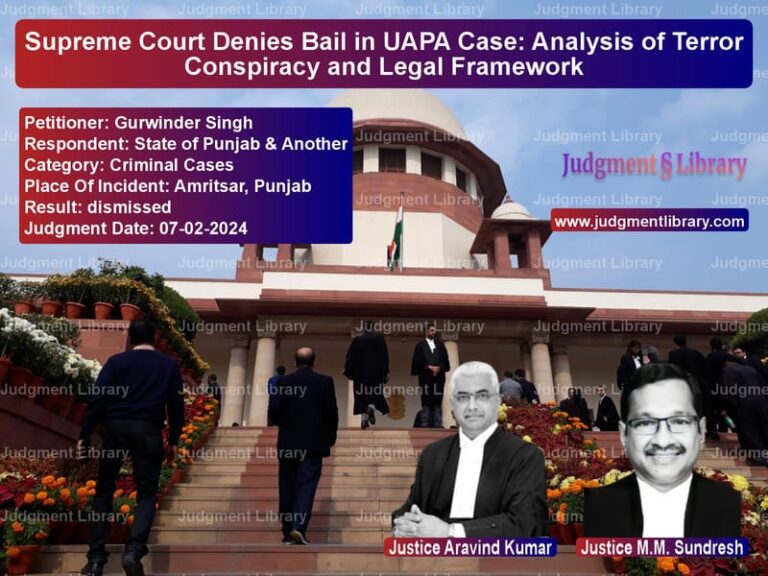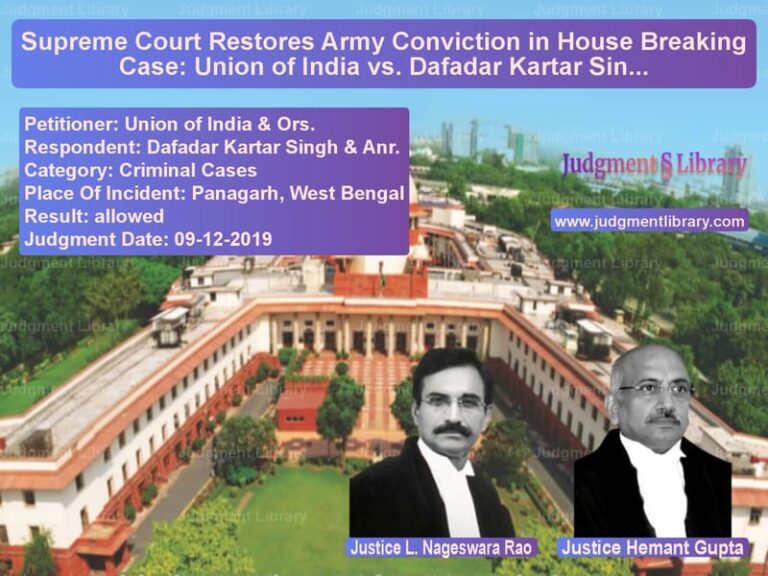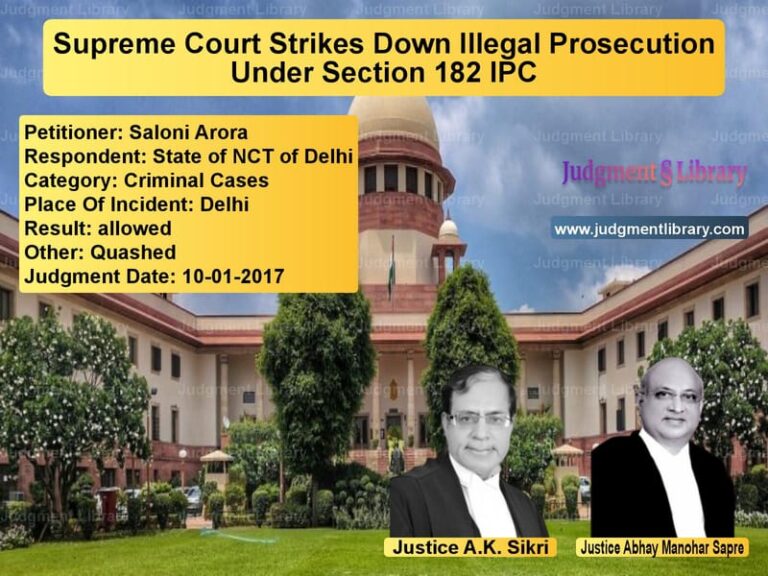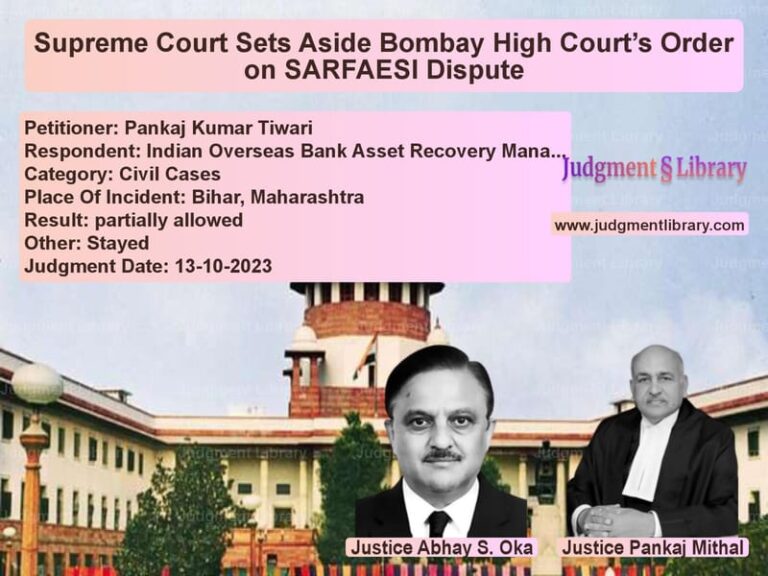Supreme Court Upholds Conviction in Uttarakhand Murder Case
The Supreme Court of India has affirmed the conviction and life imprisonment of three individuals—Chaman, Sukhbeer, and Rakesh Kumar @ Mota—who were found guilty of kidnapping and murdering a man named Jagram in Dehradun, Uttarakhand. The verdict, delivered in Criminal Appeal No. 365 of 2013, upheld the previous rulings by the High Court of Uttarakhand and the trial court.
Background of the Case
The prosecution’s case originated from an FIR lodged on June 12, 1996, by Rajo Devi, the widow of Jagram. She alleged that the accused had forcefully taken her husband away from their house in a jeep and that he was later found dead in a forest near Bijnour, Uttar Pradesh.
The motive behind the crime was alleged to be revenge. The accused suspected that Jagram’s son, Vinod, was involved in the murder of Chaman’s son. The case was based on eyewitness accounts, forensic evidence, and circumstantial evidence.
Legal Issues Considered by the Supreme Court
- Whether the prosecution had established beyond reasonable doubt that the accused kidnapped and murdered Jagram.
- Whether the recovery of the rope allegedly used in the crime was legally admissible.
- Whether the failure of neighbors to intervene weakened the prosecution’s case.
- Whether the post-mortem report and forensic findings corroborated the prosecution’s version.
Arguments by the Appellants (Chaman, Sukhbeer, and Rakesh Kumar @ Mota)
- The case was fabricated, and the accused were falsely implicated.
- The prosecution’s story lacked credibility as no neighbors intervened or testified to seeing Jagram being taken away.
- The identification of Jagram’s body was unreliable as it was heavily decomposed.
- The recovered rope did not match the description given by different prosecution witnesses.
Arguments by the Respondent (State of Uttarakhand)
- The prosecution provided direct eyewitness testimony from Rajo Devi and her daughter Manju, who saw the accused abduct Jagram.
- The accused had a clear motive for the crime—revenge for the alleged murder of Chaman’s son.
- The forensic report confirmed that the cause of death was asphyxiation.
- The rope used for the murder was recovered based on information provided by Chaman, linking him to the crime.
Supreme Court’s Judgment
The Supreme Court upheld the conviction and sentencing, making the following key observations:
- The testimony of Rajo Devi and Manju was reliable, and their identification of the accused was credible.
- The lack of intervention by neighbors did not weaken the prosecution’s case.
- The discrepancies in the description of the rope were minor and did not affect the overall credibility of the evidence.
- The failure of the accused to explain Jagram’s fate after his abduction strengthened the prosecution’s case under Section 106 of the Indian Evidence Act.
The Court also emphasized:
“Once the prosecution establishes that the accused abducted the deceased, the burden shifts to them to explain what happened thereafter. Their failure to do so justifies an adverse inference.”
The judgment reaffirmed that when a person is last seen in the company of the accused and is later found dead, a presumption of guilt arises unless adequately rebutted.
Implications of the Judgment
- The ruling strengthens the use of circumstantial evidence in criminal trials.
- It reinforces the principle that failure to explain incriminating circumstances can be used against the accused.
- It affirms the credibility of eyewitness testimonies, even if by family members, when corroborated by other evidence.
- The verdict ensures justice for victims in cases of revenge killings.
Conclusion
The Supreme Court’s decision in this case serves as a critical precedent for criminal jurisprudence in India. By upholding the conviction based on eyewitness accounts, forensic findings, and circumstantial evidence, the judgment reinforces the principle that justice must be served even in cases where direct evidence is limited. The ruling underscores the importance of accountability in criminal offenses and ensures that perpetrators of heinous crimes are punished accordingly.
Don’t miss out on the full details! Download the complete judgment in PDF format below and gain valuable insights instantly!
Download Judgment: Chaman and Another vs State of Uttarakhand Supreme Court of India Judgment Dated 19-04-2016-1741854633637.pdf
Direct Downlaod Judgment: Direct downlaod this Judgment
See all petitions in Murder Cases
See all petitions in Bail and Anticipatory Bail
See all petitions in Custodial Deaths and Police Misconduct
See all petitions in Judgment by Amitava Roy
See all petitions in Judgment by S. A. Bobde
See all petitions in dismissed
See all petitions in supreme court of India judgments April 2016
See all petitions in 2016 judgments
See all posts in Criminal Cases Category
See all allowed petitions in Criminal Cases Category
See all Dismissed petitions in Criminal Cases Category
See all partially allowed petitions in Criminal Cases Category







